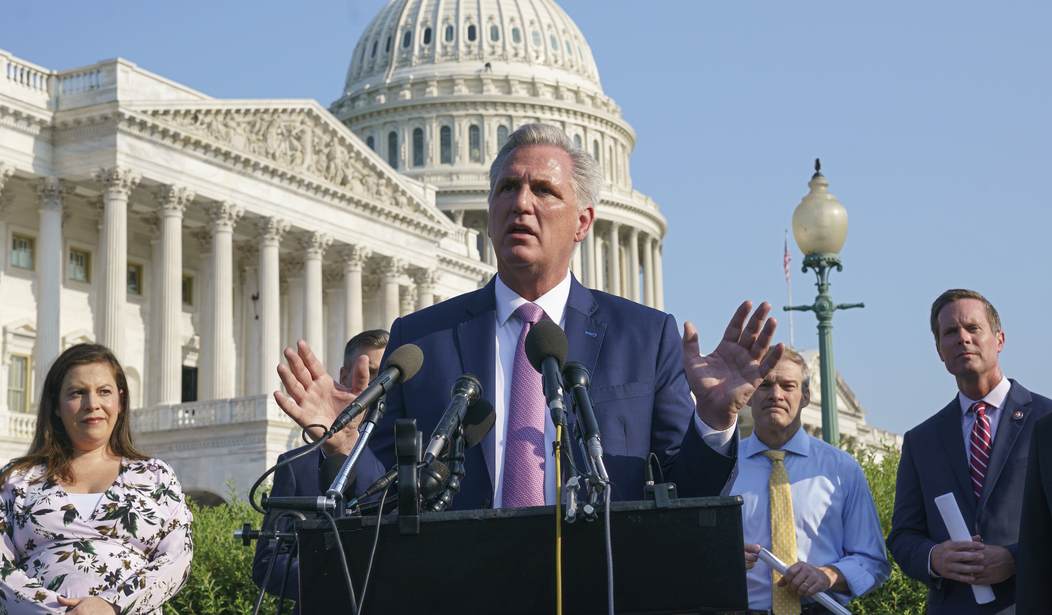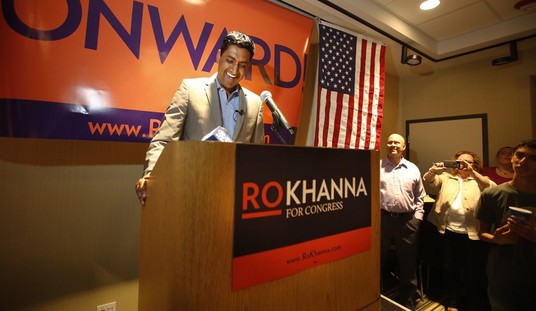A striking bit of counterprogramming from Politico during “bedwetting season” for the GOP, as news sites are overflowing today with Democratic optimism. “With Deal in Hand, Democrats Enter the Fall Armed With Something New: Hope,” the Times proclaims. “Inside Biden’s hot streak, from the poolside to the Capitol,” WaPo promises. Politico itself has a piece headlined, “Biden suddenly is piling up wins. Can Dems make it stick?”
It’s not just media hype. The latest generic ballot average at FiveThirtyEight shows, uh…

That’s the first time Democrats have led on the generic ballot since mid-November 2021.
Is the great red wave of 2022 receding before it’s arrived? Not if you believe the GOP’s internal polling. Although whether you think these numbers reflect the true state of affairs in Republican “reach” districts or whether they’ve been “skewed” somehow and leaked strategically to boost righty morale at a moment of extreme bedwetting is up to you to decide.
Four surveys conducted in late July reveal close races in open seats in Oregon, Colorado and California that President Joe Biden carried by between 11 and 15 points in 2020. Taken all together, GOP operatives view the data as a sign that Biden’s sinking approval numbers could drag Democratic candidates down enough to bring deep blue turf into reach…
Altogether, the tightening polls suggest that some super-blue seats could be in play in November, which would mean Democrats may have to expend precious resources there on defense — especially because they lack well-funded incumbents.
The most encouraging poll for Republicans came in Oregon’s new 6th District, where Republican Mike Erickson led Democratic state Rep. Andrea Salinas by 7 points, 47 percent to 40 percent, with 13 percent undecided. In a district that Biden won by nearly 14 points, his approval rating is underwater by 20 points. Republicans lead on a generic ballot by 7 points — a rough reality for a seat that Democrats drew to be safe.
Republican Christine Drazan is also in contention in a three-way race for governor in Oregon. Years of anarchic insanity in Portland may end up convincing swing voters in an otherwise reliably blue state to roll the dice on the GOP this year.
A mystery, though: If the House is out of reach for Democrats despite their “hot streak” lately, why are they now favored to win the Senate? FiveThirtyEight now gives them a 59 percent chance of retaining control of the chamber next year and even Mitch McConnell has begun to sound cautiously pessimistic. “I think it’s going to be very tight. We have a 50-50 nation. And I think when this Senate race smoke clears, we’re likely to have a very, very close Senate still, with us up slightly or the Democrats up slightly,” he told Fox News last week. A Senate that goes from 50/50 to “the Democrats up slightly” isn’t typically a hallmark of a red wave, is it?
I think the split in the party’s fortunes in the House and Senate is mostly a function of how political “gravity” affects the two chambers differently. I get paid to follow politics and it still took me a second this morning to remember who my representative in the House is, but I could tell you instantly who my two senators are. That’s not due simply to the House being four times larger than the Senate, with many more members to keep track of. It’s due to the fact that, in an age of intense partisan polarization, individual members just don’t matter much in a body that operates by simple majority rule. If Democrats always hang together on votes and Republicans always hang together on votes, the policy idiosyncracies of a given congressman are irrelevant. The size of the majority matters, nothing more.
That being so, you’d expect political “gravity” to exert a strong pull on voters’ House preferences. If you don’t know much about the candidates in your local House race and have no real reason to learn much about them, you can go into the booth and vote based on the so-called fundamentals — inflation, gas prices, your assessment of Biden’s first two years in office. To follow on with the “gravity” analogy, we might say that the fundamentals create 4 or 5 G’s of force in a House race.
Senate races are different. There really are meaningful differences between individual senators in both parties and the high bar for passing legislation created by the filibuster means that their idiosyncracies matter quite a bit to what gets passed. That’s been especially true over the past 12 months as Democrats notched surprising bipartisan wins on infrastructure, a new gun bill, the CHIPS Act, and probably gay marriage and Electoral Count Act reform before the year is out. Votes aren’t strictly party-line there — even on a matter as momentous as convicting Trump — and so voters may pay closer attention to candidates’ personal attributes when choosing a senator relative to party affiliation. I’ve pointed out before that Mehmet Oz is surely closer to the median voter on policy in Pennsylvania than far-left John Fetterman is, but Pennsylvanians thus far prefer Fetterman strongly on “personal authenticity” grounds. I doubt we’d see that matter as much in a House race, where party affiliation counts more.
So, with respect to Senate choices, the fundamentals may exert only 2 or 3 G’s on voter choice. Fetterman can achieve liftoff despite the sour mood of voters towards Democrats weighing on him whereas a Democratic House candidate weighed down by more intense forces might not.
Which is an ironic analogy in this case, since Fetterman is large enough to create his own gravitational orbit.
Even the pros are scratching their heads about the midterms now, trying to make sense of fundamentals that point to a giant red wave and polling that shows Democrats with a solid chance of gaining seats in the Senate.
According to the usual logic Sosnik uses to make predictions, Democrats should expect a “blood bath” in the fall. But he’s not so sure anymore and is questioning everything he knows about the deeper patterns of U.S. elections.
He is puzzled by one thing in particular: Which past elections offer a guide to 2022?
The question doesn’t have an easy answer, in part because times have changed — there was no recent assault on the Capitol with the partial backing of one particular party in the 1982 midterms, for instance — and in part because the nature of political partisanship has changed.
There’s no precedent either for an unpopular twice-impeached president announcing his next candidacy weeks before the midterms. Just like there’s no precedent for the most well-known Supreme Court ruling of the past 50 years going up in smoke four months before polls open and taking a constitutionally protected right with it. Even the traditional belief that big legislative wins don’t translate into electoral victories isn’t necessarily true this year. The Times notes in the piece above that LBJ’s Democratic Party got obliterated in the midterms despite pushing through his “Great Society” programs, but it’s conceivable that the surprise Build Back Better victory that progressives had given up on will restore some of their faith in the party and turn them out this fall. I’d still bet on a red wave, but not as much as I would have bet two months ago.







Join the conversation as a VIP Member